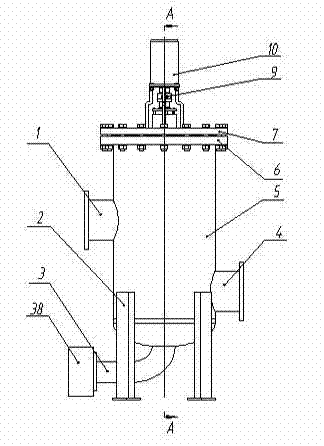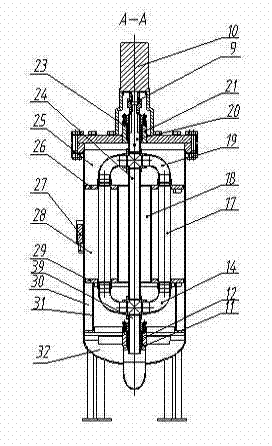Fully-automatic back-flushing type self-cleaning filter
A self-cleaning filter and backwashing technology, applied in the field of water treatment, can solve the problems of inability to clean on-line, low degree of automation, huge system system, etc., and achieve the effects of overload protection, high degree of automation and large filtering area.
- Summary
- Abstract
- Description
- Claims
- Application Information
AI Technical Summary
Problems solved by technology
Method used
Image
Examples
Embodiment Construction
[0019] Such as figure 1 and figure 2 As shown, the fully automatic backwashing self-cleaning filter of the present invention includes a cylindrical cylinder body 5, the bottom of the cylinder body 5 is fixedly supported on the support 2, and the side wall of the cylinder body 5 is provided with a water inlet 4 With the water outlet 1, the water inlet 4 and the water outlet 1 are distributed on both sides of the axis of the cylinder 5, and the water inlet 4 is below the water outlet 1. A differential pressure sensor 27 is installed near the water inlet 4 and the water outlet 1, the differential pressure sensor 27 is connected to the controller, and the differential pressure sensor 27 can be contained in a box welded with the outer wall of the cylindrical shell 5. The bottom port of the cylinder body 5 is sealed and connected with the elliptical head 32, and is sealed with the elliptical head 32. The sewage pipe 3 stretches out from the lower end of the oval head 32 . The to...
PUM
 Login to View More
Login to View More Abstract
Description
Claims
Application Information
 Login to View More
Login to View More - R&D
- Intellectual Property
- Life Sciences
- Materials
- Tech Scout
- Unparalleled Data Quality
- Higher Quality Content
- 60% Fewer Hallucinations
Browse by: Latest US Patents, China's latest patents, Technical Efficacy Thesaurus, Application Domain, Technology Topic, Popular Technical Reports.
© 2025 PatSnap. All rights reserved.Legal|Privacy policy|Modern Slavery Act Transparency Statement|Sitemap|About US| Contact US: help@patsnap.com



